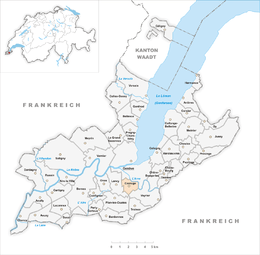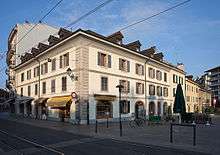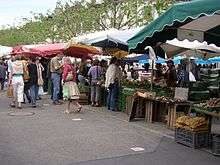Carouge
| Carouge | ||
|---|---|---|
 | ||
| ||
 Carouge | ||
|
Location of Carouge  | ||
| Coordinates: 46°11′N 6°08′E / 46.183°N 6.133°ECoordinates: 46°11′N 6°08′E / 46.183°N 6.133°E | ||
| Country | Switzerland | |
| Canton | Geneva | |
| District | n.a. | |
| Government | ||
| • Executive |
Conseil administratif with 3 members | |
| • Mayor | Maire (list) | |
| • Parliament |
Conseil municipal with 31 members | |
| Area[1] | ||
| • Total | 2.7 km2 (1.0 sq mi) | |
| Elevation | 386 m (1,266 ft) | |
| Population (Dec 2015[2]) | ||
| • Total | 21,342 | |
| • Density | 7,900/km2 (20,000/sq mi) | |
| Postal code | 1227 | |
| SFOS number | 6608 | |
| Surrounded by | Geneva (Genève), Lancy, Plan-les-Ouates, Troinex, Veyrier | |
| Website |
www SFSO statistics | |
Carouge is a municipality in the Canton of Geneva, Switzerland, with a population of 19,114 (2007).
History
Carouge is first mentioned in the Early Middle Ages as Quadruvium and Quatruvio. In 1248 it was mentioned as Carrogium while in the 14th Century it was known as Quarrouiz or Quarroggi. In 1445 it was mentioned as Quaroggio.[3] The current city was built from the ground up, by Victor Amadeus III of Sardinia, King of Sardinia and Duke of Savoy, starting on 31 January 1786.[3]
Geography
Carouge has an area, as of 2009, of 2.7 square kilometers (1.0 sq mi). Of this area, 0.13 km2 (0.050 sq mi) or 4.8% is used for agricultural purposes, while 0.23 km2 (0.089 sq mi) or 8.5% is forested. Of the rest of the land, 2.25 km2 (0.87 sq mi) or 83.3% is settled (buildings or roads), 0.04 km2 (9.9 acres) or 1.5% is either rivers or lakes.[4]
Of the built up area, industrial buildings made up 18.5% of the total area while housing and buildings made up 31.9% and transportation infrastructure made up 20.7%. Power and water infrastructure as well as other special developed areas made up 4.1% of the area while parks, green belts and sports fields made up 8.1%. Out of the forested land, 6.3% of the total land area is heavily forested and 2.2% is covered with orchards or small clusters of trees. Of the agricultural land, 3.3% is used for growing crops and 1.5% is pastures. All the water in the municipality is flowing water.[4]
The municipality is located south of the Rhone and Arve rivers.
Demographics
| Nationality | Amount | % total (population) |
|---|---|---|
| 1,972 | 9.5 | |
| 1,156 | 5.6 | |
| 1,038 | 5.0 | |
| 618 | 3.0 | |
| 196 | 0.9 | |
| 182 | 0.9 | |
| 174 | 0.8 | |
| 167 | 0.8 | |
| 128 | 0.6 | |
| 112 | 0.5 | |
| 98 | 0.5 | |
| 86 | 0.4 | |
| 71 | 0.3 | |
| 69 | 0.3 | |
| 65 | 0.3 | |
| 62 | 0.3 | |
| 60 | 0.3 | |
| 57 | 0.3 | |
| 57 | 0.3 | |
| 52 | 0.2 | |


Carouge has a population (as of December 2015) of 21,342.[2] As of 2008, 37.7% of the population are resident foreign nationals.[6] Over the last 10 years (1999–2009 ) the population has changed at a rate of 21%. It has changed at a rate of 15.6% due to migration and at a rate of 5.1% due to births and deaths.[7]
Most of the population (as of 2000) speaks French (13,700 or 77.9%), with Portuguese being second most common (921 or 5.2%) and Italian being third (846 or 4.8%). There are 567 people who speak German and 9 people who speak Romansh.[8]
As of 2008, the gender distribution of the population was 47.9% male and 52.1% female. The population was made up of 5,775 Swiss men (28.7% of the population) and 3,868 (19.2%) non-Swiss men. There were 6,887 Swiss women (34.2%) and 3,586 (17.8%) non-Swiss women.[9] Of the population in the municipality 3,489 or about 19.8% were born in Carouge and lived there in 2000. There were 3,845 or 21.9% who were born in the same canton, while 2,653 or 15.1% were born somewhere else in Switzerland, and 6,668 or 37.9% were born outside of Switzerland.[8]
The total Swiss population change in 2008 (from all sources, including moves across municipal borders) was an increase of 195 and the non-Swiss population increased by 427 people. This represents a population growth rate of 3.3%.[6]
The age distribution of the population (as of 2000) is children and teenagers (0–19 years old) make up 21.4% of the population, while adults (20–64 years old) make up 65.1% and seniors (over 64 years old) make up 13.4%.[7] As of 2000, there were 7,867 people who were single and never married in the municipality. There were 7,452 married individuals, 881 widows or widowers and 1,390 individuals who are divorced.[8]
As of 2000, there were 8,121 private households in the municipality, and an average of 2 persons per household.[7] There were 3,619 households that consist of only one person and 268 households with five or more people. Out of a total of 8,366 households that answered this question, 43.3% were households made up of just one person and there were 38 adults who lived with their parents. Of the rest of the households, there are 1,731 married couples without children, 1,958 married couples with children. There were 625 single parents with a child or children. There were 150 households that were made up of unrelated people and 245 households that were made up of some sort of institution or another collective housing.[8]
In 2000 there were 145 single family homes (or 14.6% of the total) out of a total of 995 inhabited buildings. There were 349 multi-family buildings (35.1%), along with 384 multi-purpose buildings that were mostly used for housing (38.6%) and 117 other use buildings (commercial or industrial) that also had some housing (11.8%). Of the single family homes 57 were built before 1919, while 11 were built between 1990 and 2000.[10]
In 2000 there were 8,925 apartments in the municipality. The most common apartment size was 3 rooms of which there were 2,810. There were 1,587 single room apartments and 815 apartments with five or more rooms. Of these apartments, a total of 7,927 apartments (88.8% of the total) were permanently occupied, while 873 apartments (9.8%) were seasonally occupied and 125 apartments (1.4%) were empty.[10] As of 2009, the construction rate of new housing units was 4.7 new units per 1000 residents.[7] The vacancy rate for the municipality, in 2010, was 0.13%.[7]
The historical population is given in the following chart:[3][11]

Heritage sites of national significance
The Archives of Carouge is listed as a Swiss heritage site of national significance. The entire village of Carouge is listed in the Inventory of Swiss Heritage Sites.[12]
Politics
In the 2007 federal election the most popular party was the SP which received 20.5% of the vote. The next three most popular parties were the Green Party (18.77%), the SVP (18.09%) and the FDP (10.49%). In the federal election, a total of 4,482 votes were cast, and the voter turnout was 46.6%.[13][14]
For the 2009 Conseil d'Etat election, there were a total of 9,805 registered voters of which 4,612 (47.0%) voted.[14]
Economy
As of 2010, Carouge had an unemployment rate of 9.3%. As of 2008, there were people employed in the primary economic sector and about businesses involved in this sector. 3,414 people were employed in the secondary sector and there were 320 businesses in this sector. 18,003 people were employed in the tertiary sector, with 1,492 businesses in this sector.[7] There were 9,073 residents of the municipality who were employed in some capacity, of which females made up 46.5% of the workforce.
In 2008 the total number of full-time equivalent jobs was 18,636. The number of jobs in the primary sector was, all of which were in agriculture. The number of jobs in the secondary sector was 3,272 of which 1,612 or (49.3%) were in manufacturing and 1,599 (48.9%) were in construction. The number of jobs in the tertiary sector was 15,364. In the tertiary sector; 2,536 or 16.5% were in wholesale or retail sales or the repair of motor vehicles, 594 or 3.9% were in the movement and storage of goods, 590 or 3.8% were in a hotel or restaurant, 903 or 5.9% were in the information industry, 3,319 or 21.6% were the insurance or financial industry, 2,859 or 18.6% were technical professionals or scientists, 723 or 4.7% were in education and 1,219 or 7.9% were in health care.[15]
In 2000, there were 18,589 workers who commuted into the municipality and 6,612 workers who commuted away. The municipality is a net importer of workers, with about 2.8 workers entering the municipality for every one leaving. About 16.7% of the workforce coming into Carouge are coming from outside Switzerland, while 0.1% of the locals commute out of Switzerland for work.[16] Of the working population, 32.2% used public transportation to get to work, and 36.2% used a private car.[7]
Religion

From the 2000 census, 7,816 or 44.4% were Roman Catholic, while 2,381 or 13.5% belonged to the Swiss Reformed Church. Of the rest of the population, there were 221 members of an Orthodox church (or about 1.26% of the population), there were 57 individuals (or about 0.32% of the population) who belonged to the Christian Catholic Church, and there were 244 individuals (or about 1.39% of the population) who belonged to another Christian church. There were 75 individuals (or about 0.43% of the population) who were Jewish, and 643 (or about 3.66% of the population) who were Islamic. There were 52 individuals who were Buddhist, 16 individuals who were Hindu and 37 individuals who belonged to another church. 4,306 (or about 24.48% of the population) belonged to no church, are agnostic or atheist, and 1,742 individuals (or about 9.90% of the population) did not answer the question.[8]
Sports and sights
Etoile Carouge is the football club and they currently play in the Swiss Challenge League. There is an outdoor Olympic swimming pool known as Piscine de la Fontenette and the indoor Piscine des Pervenches. Carouge has a museum, the Musée de Carouge, the cinema, Bio 72, which exclusively plays indie films; and a popular theatre, the Théâtre de Carouge. Arve river, which borders Carouge from the north-east, has a walking and cycling path running along it. Carouge also has a free bicycle rental station (Genève roule), at Place de l'Octroi.
Education
In Carouge about 5,230 or (29.7%) of the population have completed non-mandatory upper secondary education, and 3,244 or (18.4%) have completed additional higher education (either university or a Fachhochschule). Of the 3,244 who completed tertiary schooling, 37.3% were Swiss men, 33.7% were Swiss women, 16.3% were non-Swiss men and 12.8% were non-Swiss women.[8]
During the 2009-2010 school year there were a total of 3,816 students in the Carouge school system. The education system in the Canton of Geneva allows young children to attend two years of non-obligatory Kindergarten.[17] During that school year, there were 377 children who were in a pre-kindergarten class. The canton's school system provides two years of non-mandatory kindergarten and requires students to attend six years of primary school, with some of the children attending smaller, specialized classes. In Carouge there were 619 students in kindergarten or primary school and 83 students were in the special, smaller classes. The secondary school program consists of three lower, obligatory years of schooling, followed by three to five years of optional, advanced schools. There were 619 lower secondary students who attended school in Carouge. There were 866 upper secondary students from the municipality along with 217 students who were in a professional, non-university track program. An additional 135 students attended a private school.[18]
As of 2000, there were 1,577 students in Carouge who came from another municipality, while 1,012 residents attended schools outside the municipality.[16]
References
- ↑ Arealstatistik Standard - Gemeindedaten nach 4 Hauptbereichen
- 1 2 Swiss Federal Statistical Office - STAT-TAB, online database – Ständige und nichtständige Wohnbevölkerung nach institutionellen Gliederungen, Geburtsort und Staatsangehörigkeit (German) accessed 30 August 2016
- 1 2 3 Carouge in German, French and Italian in the online Historical Dictionary of Switzerland.
- 1 2 Swiss Federal Statistical Office-Land Use Statistics 2009 data (German) accessed 25 March 2010
- ↑ "Population résidante permanente et non permanente selon les niveaux géographiques institutionnels, le lieu de naissance et la nationalité" (in French). bfs.admin.ch. Retrieved 6 July 2015.
- 1 2 Swiss Federal Statistical Office - Superweb database - Gemeinde Statistics 1981-2008 Archived June 28, 2010, at the Wayback Machine. (German) accessed 19 June 2010
- 1 2 3 4 5 6 7 Swiss Federal Statistical Office Archived January 5, 2016, at the Wayback Machine. accessed 22-April-2011
- 1 2 3 4 5 6 STAT-TAB Datenwürfel für Thema 40.3 - 2000 Archived April 9, 2014, at the Wayback Machine. (German) accessed 2 February 2011
- ↑ Canton of Geneva Statistical Office Population résidante du canton de Genève, selon l'origine et le sexe, par commune, en mars 2011(French) accessed 18 April 2011
- 1 2 Federal Statistical Office STAT-TAB - Datenwürfel für Thema 09.2 - Gebäude und Wohnungen Archived January 21, 2015, at the Wayback Machine. (German) accessed 28 January 2011
- ↑ Swiss Federal Statistical Office STAT-TAB Bevölkerungsentwicklung nach Region, 1850-2000 Archived September 30, 2014, at the Wayback Machine. (German) accessed 29 January 2011
- ↑ "Kantonsliste A-Objekte:Geneva" (PDF). KGS Inventar (in German). Federal Office of Civil Protection. 2009. Archived from the original (PDF) on 28 September 2011. Retrieved 12 July 2010.
- ↑ Swiss Federal Statistical Office, Nationalratswahlen 2007: Stärke der Parteien und Wahlbeteiligung, nach Gemeinden/Bezirk/Canton Archived May 14, 2015, at the Wayback Machine. (German) accessed 28 May 2010
- 1 2 Canton of Geneva Statistical Office Election Results from multiple spreadsheets (French) accessed 18 April 2011
- ↑ Swiss Federal Statistical Office STAT-TAB Betriebszählung: Arbeitsstätten nach Gemeinde und NOGA 2008 (Abschnitte), Sektoren 1-3 Archived December 25, 2014, at the Wayback Machine. (German) accessed 28 January 2011
- 1 2 Swiss Federal Statistical Office - Statweb (German) accessed 24 June 2010
- ↑ EDK/CDIP/IDES (2010). Kantonale Schulstrukturen In Der Schweiz Und Im Fürstentum Liechtenstein / Structures Scolaires Cantonales En Suisse Et Dans La Principauté Du Liechtenstein (PDF) (Report). Retrieved 24 June 2010.
- ↑ Canton of Geneva Statistical Office Elèves résidant dans le canton de Genève, selon le niveau d'enseignement, par commune de domicile (French) accessed 18 April 2011
External links
| Wikimedia Commons has media related to Carouge. |
- Official Website (French)
